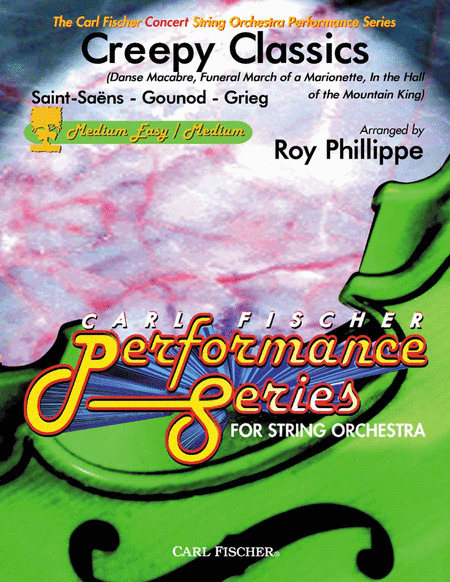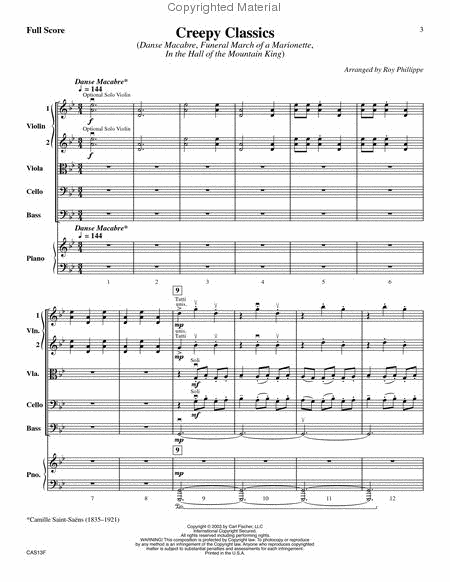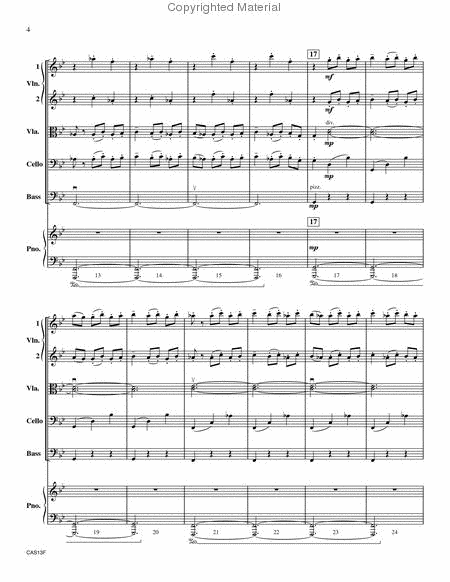Creepy Classics
Danse Macabre, Funeral March of a Marionette, In the Hall of the Mountain King
-
Ships in 1 to 2 weeks
Details
Description
SKU: CF.CAS13
Danse Macabre, Funeral March of a Marionette, In the Hall of the Mountain King. Composed by Camille Saint-Saens, Charles Francois Gounod, and Edvard Grieg. Arranged by Roy Phillippe. Carl Fischer Concert String Orchestra Series. Classical. Score and Parts. With Standard notation. 16+16+4+10+10+3+10+12 pages. Carl Fischer Music #CAS13. Published by Carl Fischer Music (CF.CAS13).ISBN 9780825851858. UPC: 798408051853. 8.5 X 11 inches. Key: G minor.
Creepy Classics is a medley of themes from the dark side of classical music. I hope it offers a little something different to your concert programming. Dynamics and articulations are always important but especially so in this arrangement, where the contrasts are particularly dramatic. We begin with Danse Macabre by Camille Saint-Saens (1835-1921). Staying faithful to the original orchestration, the introduction is performed by a solo violin with its E-string tuned down a half step. This necessitates the soloist having a second violin with normal tuning at hand so as to join the section after the solo. If this is not practical, divide the parts between two players or the section. The melody is passed among sections and the Danse ends in m. 41. At this point, we begin our second theme, the famous Funeral March of a Marionette by Charles Gounod (1818-1893). Many in your audience will recognize this as the theme from the Alfred Hitchcock television series. It begins quietly and crescendos as the piece intensifies. The dynamics are very important in m. 59, where we have a forte accent on the first beat, dropping to piano on the second beat. The same occurs in m. 61. We are back to mezzo forte in m.67. A crescendo begins in m.70, concluding the March in m.74. At m.75 we have a slow transition section leading to the final selection, in The Hall of the Mountain King by Edvard Grieg (1843-1907). The tempo picks up in m.79 with pizzicato in the cello and basses. At m. 81 the melody begins in the celli with half the players playing pizzicato, and the other half arco. The violins and violas join in the melody and by m. 93 everyone is playing forte. A crescendo gradually begins building into fortissimo and merges with an accelerando in m.97 taking us to the final Presto at m. 104, where the piece ends with dramatic, accented chords. I hope you and your orchestra enjoy performing Creepy Classics. - Roy Phillippe Spring 2003.
Creepy ClassicsA is a medley of themes from the dark side of classical music. I hope it offers a little something different to your concert programming. Dynamics and articulations are always important but especially so in this arrangement, where the contrasts are particularly dramatic. We begin withA Danse MacabreA by Camille Saint-Saens (1835-1921). Staying faithful to the original orchestration, the introduction is performed by a solo violin with its E-string tuned down a half step. This necessitates the soloist having a second violin with normal tuning at hand so as to join the section after the solo. If this is not practical, divide the parts between two players or the section. The melody is passed among sections and the Danse ends in m. 41. At this point, we begin our second theme, the famousA Funeral March of a MarionetteA by Charles Gounod (1818-1893). Many in your audience will recognize this as the theme from the Alfred Hitchcock television series. It begins quietly and crescendos as the piece intensifies. The dynamics are very important in m. 59, where we have a forte accent on the first beat, dropping to piano on the second beat. The same occurs in m. 61. We are back toA mezzo forteA in m.67. A crescendo begins in m.70, concluding the March in m.74. At m.75 we have a slow transition section leading to the final selection, inA The Hall of the Mountain KingA by Edvard Grieg (1843-1907). The tempo picks up in m.79 with pizzicato in the cello and basses. At m. 81 the melody begins in the celli with half the players playing pizzicato, and the other half arco. The violins and violas join in the melody and by m. 93 everyone is playingA forte. AA crescendo gradually begins building intoA fortissimoA and merges with anA accelerando in m.97 taking us to the finalA Presto at m. 104, where the piece ends with dramatic, accented chords. I hope you and your orchestra enjoy performingA Creepy Classics. - Roy Phillippe Spring 2003.
Creepy ClassicsA is a medley of themes from the "dark side" of classical music. I hope it offers a little something different to your concert programming. Dynamics and articulations are always important but especially so in this arrangement, where the contrasts are particularly dramatic. We begin withA Danse MacabreA by Camille Saint-Saens (1835-1921). Staying faithful to the original orchestration, the introduction is performed by a solo violin with its E-string tuned down a half step. This necessitates the soloist having a second violin with normal tuning at hand so as to join the section after the solo. If this is not practical, divide the parts between two players or the section. The melody is passed among sections and the Danse ends in m. 41. At this point, we begin our second theme, the famousA Funeral March of a MarionetteA by Charles Gounod (1818-1893). Many in your audience will recognize this as the theme from the Alfred Hitchcock television series. It begins quietly and crescendos as the piece intensifies. The dynamics are very important in m. 59, where we have a forte accent on the first beat, dropping to piano on the second beat. The same occurs in m. 61. We are back toA mezzo forteA in m.67. A crescendo begins in m.70, concluding the March in m.74. At m.75 we have a slow transition section leading to the final selection, inA The Hall of the Mountain KingA by Edvard Grieg (1843-1907). The tempo picks up in m.79 with pizzicato in the cello and basses. At m. 81 the melody begins in the celli with half the players playing pizzicato, and the other half arco. The violins and violas join in the melody and by m. 93 everyone is playingA forte. AA crescendo gradually begins building intoA fortissimoA and merges with anA accelerando in m.97 taking us to the finalA Presto at m. 104, where the piece ends with dramatic, accented chords. I hope you and your orchestra enjoy performingA Creepy Classics. - Roy Phillippe Spring 2003.
Creepy Classics is a medley of themes from the "dark side" of classical music. I hope it offers a little something different to your concert programming. Dynamics and articulations are always important but especially so in this arrangement, where the contrasts are particularly dramatic. We begin with Danse Macabre by Camille Saint-Saens (1835-1921). Staying faithful to the original orchestration, the introduction is performed by a solo violin with its E-string tuned down a half step. This necessitates the soloist having a second violin with normal tuning at hand so as to join the section after the solo. If this is not practical, divide the parts between two players or the section. The melody is passed among sections and the Danse ends in m. 41. At this point, we begin our second theme, the famous Funeral March of a Marionette by Charles Gounod (1818-1893). Many in your audience will recognize this as the theme from the Alfred Hitchcock television series. It begins quietly and crescendos as the piece intensifies. The dynamics are very important in m. 59, where we have a forte accent on the first beat, dropping to piano on the second beat. The same occurs in m. 61. We are back to mezzo forte in m.67. A crescendo begins in m.70, concluding the March in m.74. At m.75 we have a slow transition section leading to the final selection, in The Hall of the Mountain King by Edvard Grieg (1843-1907). The tempo picks up in m.79 with pizzicato in the cello and basses. At m. 81 the melody begins in the celli with half the players playing pizzicato, and the other half arco. The violins and violas join in the melody and by m. 93 everyone is playing forte. A crescendo gradually begins building into fortissimo and merges with an accelerando in m.97 taking us to the final Presto at m. 104, where the piece ends with dramatic, accented chords. I hope you and your orchestra enjoy performing Creepy Classics. - Roy Phillippe Spring 2003.
Creepy Classics is a medley of themes from the "dark side" of classical music. I hope it offers a little something different to your concert programming. Dynamics and articulations are always important but especially so in this arrangement, where the contrasts are particularly dramatic. We begin with Danse Macabre by Camille Saint-Saens (1835-1921). Staying faithful to the original orchestration, the introduction is performed by a solo violin with its E-string tuned down a half step. This necessitates the soloist having a second violin with normal tuning at hand so as to join the section after the solo. If this is not practical, divide the parts between two players or the section. The melody is passed among sections and the Danse ends in m. 41. At this point, we begin our second theme, the famous Funeral March of a Marionette by Charles Gounod (1818-1893). Many in your audience will recognize this as the theme from the Alfred Hitchcock television series. It begins quietly and crescendos as the piece intensifies. The dynamics are very important in m. 59, where we have a forte accent on the first beat, dropping to piano on the second beat. The same occurs in m. 61. We are back to mezzo forte in m.67. A crescendo begins in m.70, concluding the March in m.74. At m.75 we have a slow transition section leading to the final selection, in The Hall of the Mountain King by Edvard Grieg (1843-1907). The tempo picks up in m.79 with pizzicato in the cello and basses. At m. 81 the melody begins in the celli with half the players playing pizzicato, and the other half arco. The violins and violas join in the melody and by m. 93 everyone is playing forte. A crescendo gradually begins building into fortissimo and merges with an accelerando in m.97 taking us to the final Presto at m. 104, where the piece ends with dramatic, accented chords. I hope you and your orchestra enjoy performing Creepy Classics. - Roy Phillippe Spring 2003.
Creepy Classics is a medley of themes from the "dark side" of classical music. I hope it offers a little something different to your concert programming. Dynamics and articulations are always important but especially so in this arrangement, where the contrasts are particularly dramatic.We begin with Danse Macabre by Camille Saint-Saëns (1835-1921). Staying faithful to the original orchestration, the introduction is performed by a solo violin with its E-string tuned down a half step. This necessitates the soloist having a second violin with normal tuning at hand so as to join the section after the solo. If this is not practical, divide the parts between two players or the section. The melody is passed among sections and the Danse ends in m. 41. At this point, we begin our second theme, the famous Funeral March of a Marionette by Charles Gounod (1818-1893). Many in your audience will recognize this as the theme from the Alfred Hitchcock television series.It begins quietly and crescendos as the piece intensifies. The dynamics are very important in m. 59, where we have a forte accent on the first beat, dropping to piano on the second beat. The same occurs in m. 61. We are back to mezzo forte in m.67. A crescendo begins in m.70, concluding the March in m.74. At m.75 we have a slow transition section leading to the final selection, in The Hall of the Mountain King by Edvard Grieg (1843-1907). The tempo picks up in m.79 with pizzicato in the cello and basses. At m. 81 the melody begins in the celli with half the players playing pizzicato, and the other half arco. The violins and violas join in the melody and by m. 93 everyone is playing forte. A crescendo gradually begins building into fortissimo and merges with an accelerando in m.97 taking us to the final Presto at m. 104, where the piece ends with dramatic, accented chords.I hope you and your orchestra enjoy performing Creepy Classics.- Roy PhillippeSpring 2003.
About Carl Fischer Concert String Orchestra Series
This series of pieces (Grade 3 and higher) is designed for advancing ensembles. The pieces in this series are characterized by:
- Expanded use of rhythms, ranges and keys but technical demands are still carefully considered
- More comprehensive bowing techniques
- Viola T.C. included
- Careful selection of keys and degree of difficulty for advancing musicians
Song List (3)
- Danse Macabre
- Funeral March of a Marionette
- In the Hall of the Mountain King



 Share
Share